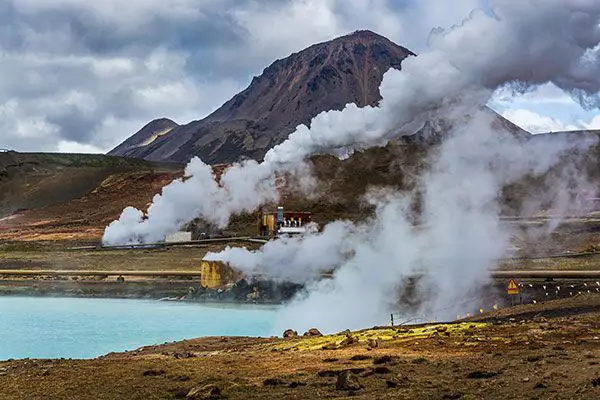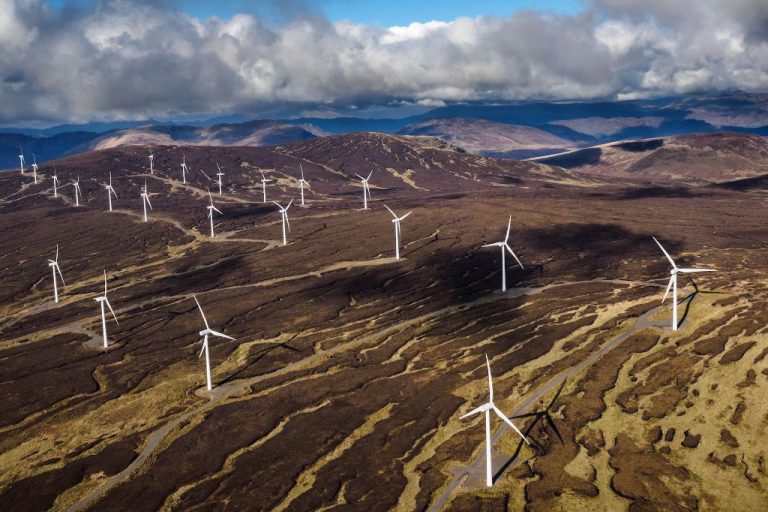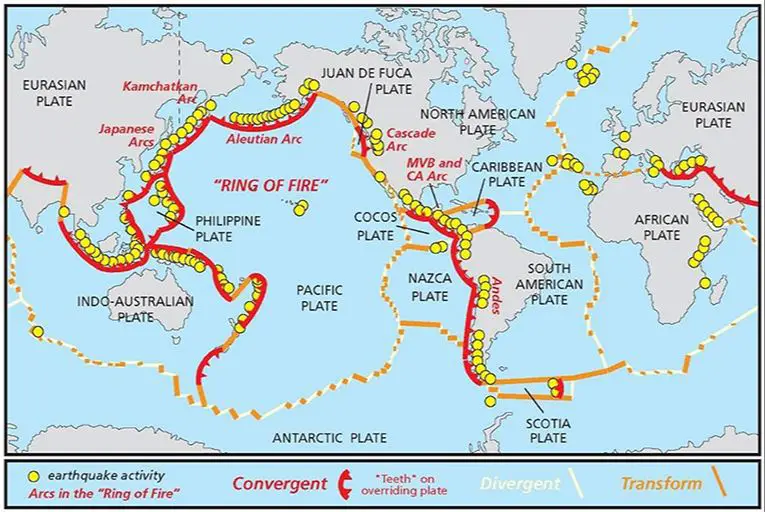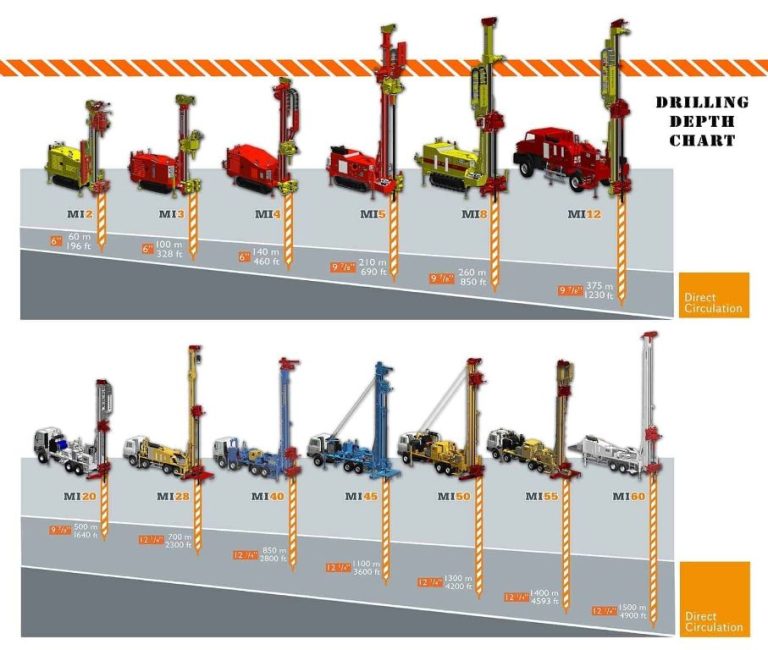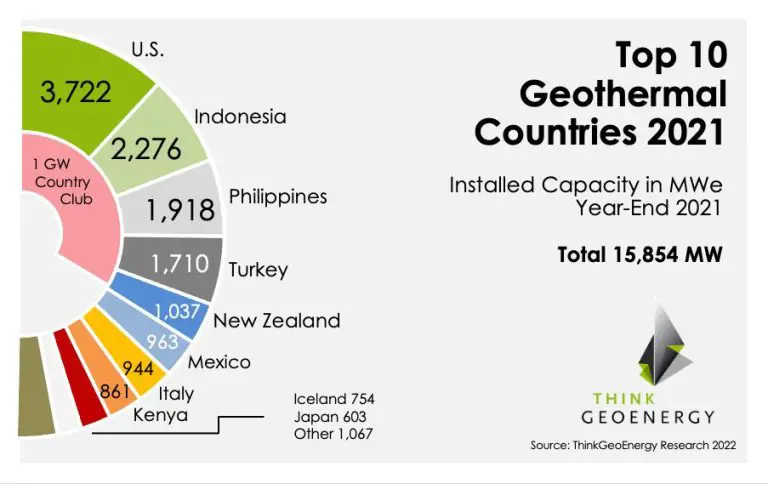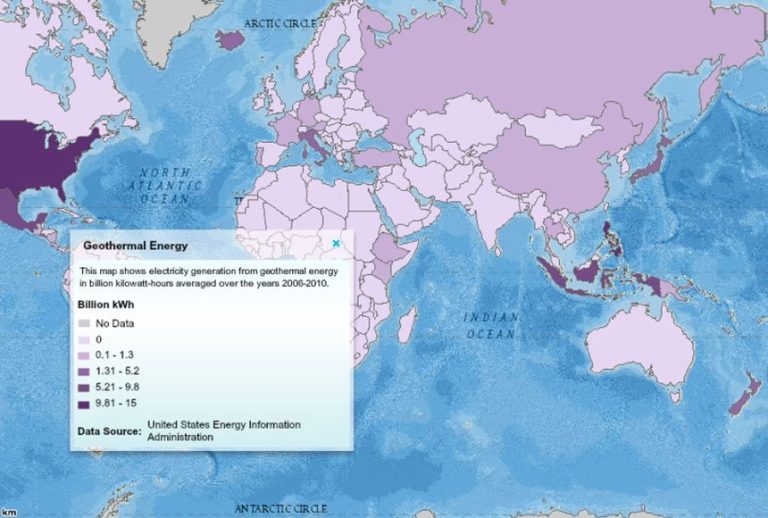Where Is Geothermal Energy Mostly Found?
Geothermal energy is thermal energy generated and stored within the Earth that can be used for electricity generation and heating. It is a renewable energy source that originates from the heat retained inside the earth’s core, from radioactive decay of minerals, and from solar energy absorbed at the surface. There are three main types of geothermal energy systems:
- Hydrothermal systems, where there are hot water reservoirs near the surface
- Geo-pressured systems that contain hot water mixed with natural gas under pressure
- Hot dry rock, where no natural fluid or steam exists so water is injected to create a geothermal reservoir
Geothermal energy has several key benefits that make it a valuable renewable energy source:
- It is eco-friendly and sustainable since it taps heat already present below the earth’s surface
- It provides constant baseload power unaffected by weather changes
- It has a small land footprint compared to other renewable sources
- The hot water byproduct can be used for heating homes and buildings
- It is location flexible and can be built nearly anywhere with proper subsurface heat and fluid
Geological Requirements for Geothermal Energy
In order for an area to be suitable for geothermal energy production, it must have a few key geological features underground:
Underground Heat Sources
There needs to be a hot spot deep below the earth’s surface providing a source of heat. This heat often comes from hot magma or molten rocks. Areas with recent volcanic activity typically have good sources of underground heat.
Permeable Rock
The underground hot spot needs to be covered in permeable rock. This allows fluids to flow through cracks or pores in the rock, gathering heat. Impermeable rock would prevent fluids from circulating and absorbing enough heat.
Accessible Fluids
Hot water, steam, or brine must be available and able to flow readily through the permeable rock. This heated fluid transports the geothermal energy to the surface, where it can be tapped as an energy source. Areas lacking accessible fluids would not have viable geothermal resources.
Primary Locations of Geothermal Energy
Geothermal energy is mostly found in areas with significant geological activity that allows heat from deep within the Earth to reach the surface. The primary locations for geothermal energy are along major tectonic plate boundaries, in volcanically active areas, and in regions with geysers or hot springs.
Plate boundaries are locations where tectonic plates meet and move past each other. This movement causes friction that heats rock in the Earth’s crust. Major plate boundaries, like the “Ring of Fire” around the Pacific Ocean, have high levels of volcanic and seismic activity that make them prime spots for geothermal energy.
Volcanic areas, such as Iceland or Indonesia, also provide ideal conditions for geothermal resources. Magma from deep within the Earth heats groundwater, which can emerge as hot springs or geysers at the surface. Countries with many active volcanoes often have abundant geothermal reserves.
The presence of hot springs or geysers at Earth’s surface is a clear indicator of accessible geothermal resources. These surface features are created when heated water rises from depth and emerges above ground. Hot spring regions worldwide, like Yellowstone National Park in the U.S., are excellent locations to utilize geothermal power.
Western United States
The Western United States has abundant geothermal resources due to its location along the seismically active Pacific Ring of Fire. Three major geothermal areas in the West are:
The Geysers in Northern California – This is the largest geothermal field in the world, located about 100 miles north of San Francisco. The Geysers span an area of about 30 square miles and have more than 350 steam wells that generate around 725 megawatts of electricity, enough to power a city the size of San Francisco.
Yellowstone in Wyoming – Yellowstone is located on top of a supervolcano that releases about two-thirds of the world’s geysers and hot springs. Popular geyser attractions include Old Faithful and the Grand Prismatic Spring. Small pilot projects in Wyoming harness pockets of geothermal resources in the Yellowstone region.
Nevada – Nevada has major geothermal electric plants at Steamboat Springs, Brady’s Hot Springs, Desert Peak, and Beowawe. These plants generate over 70 megawatts of electricity. Nevada has the second highest geothermal production in the nation after California.
Iceland
Iceland is one of the world’s premier locations for geothermal energy due to its unique geological location. The island nation sits directly on top of the Mid-Atlantic Ridge, where the North American and Eurasian tectonic plates are slowly spreading apart. This divergent boundary creates ideal conditions for geothermal energy, as it allows hot mantle material to rise close to the surface.
Iceland is also known for its high levels of volcanic activity. The island has over 130 volcanoes, many of which are still active due to the upwelling of magma from deep within the Earth. This abundant volcanism ensures a plentiful supply of underground heat that can be harnessed for geothermal power generation and heating.
Thanks to these highly favorable geological conditions, Iceland generates over 25% of its total electricity from geothermal sources. The country also uses geothermal energy to heat approximately 90% of its buildings. Iceland’s vast geothermal resources have allowed it to become a model for the widespread utilization of this clean, renewable energy around the world.
New Zealand
New Zealand sits across the boundary of two tectonic plates, making it prone to volcanic and seismic activity. Its location on the Pacific Ring of Fire gives the country enormous potential for geothermal energy production.
Geothermal resources provide approximately 17% of New Zealand’s electricity generation capacity. Major geothermal development is concentrated in the Taupo Volcanic Zone located in the central North Island. There are over 200 high-temperature geothermal fields and a dozen existing geothermal power stations throughout the region.
The country aims to continue developing its abundant geothermal resources to meet its goal of producing 100% renewable electricity by 2035. With further expansion planned, geothermal power is positioned to continue playing a key role in New Zealand’s renewable energy future.
Japan
Japan is one of the leading countries for geothermal energy thanks to its location along the so-called Pacific Ring of Fire, an area known for high volcanic and seismic activity. This geologically active location means Japan has abundant geothermal resources to tap for energy production.
With over 500 geothermal power plants, Japan generates about 3.5 gigawatts of energy from geothermal sources. This accounts for about 5% of the country’s total electricity generation capacity. Japan began exploring geothermal energy in the 1960s and installed the first geothermal power plant in 1966 in Matsukawa, on the island of Honshu. Since then, continued innovation and investment in the industry has allowed Japan to become a world leader in geothermal technology and know-how.
Indonesia
One of the regions with the most abundant geothermal resources is Indonesia, which is situated along the Pacific Ring of Fire. This active volcanic region accounts for a massive 40% of the world’s total geothermal resources. Indonesia contains over 200 active volcanoes clustered mainly on the islands of Sumatra, Java, Bali, Lombok and Flores. These regions have extremely high subsurface temperatures that provide ideal conditions for generating geothermal power. Indonesia has set ambitious goals to tap this vast geothermal potential. By 2025, the government aims to produce over 9,000 megawatts of electricity from geothermal, which would meet about 5% of the country’s needs. While Indonesia currently ranks third globally in geothermal power generation, surpassed only by the United States and Philippines, it likely contains the greatest capacity for growth if further resources can be developed.
East Africa Rift
The East African Rift is another major geothermal region, with extensive resources in several countries. This rift valley runs for over 3,000 miles from the Gulf of Aden to Zimbabwe. Volcanic activity here occurs as the African plate splits into the Nubian and Somalian tectonic plates. This continental rift allows magma to rise closer to the surface.
Ethiopia sits atop the East African Rift and contains significant untapped geothermal potential, estimated at over 10,000 MW. So far, only about 7 MW has been developed in the country. Kenya follows with about 676 MW of installed geothermal capacity, most located near the Olkaria geothermal fields. Geothermal accounts for around half of Kenya’s electricity generation. Tanzania also has sizable geothermal resources estimated at 650 MW, but less than 40 MW developed so far.
Conclusion
In summary, the major geothermal locations around the world include the western United States, Iceland, New Zealand, Japan, Indonesia, and the East Africa Rift. What all these locations have in common are the ideal geological factors that make geothermal energy production possible – high heat flow from the Earth’s molten interior, tectonic plate boundaries, volcanic activity, and shallow magma chambers. The Earth’s internal heat drives hydrothermal convection that brings hot water and steam to the surface, which can then be tapped as a renewable energy source. Iceland and New Zealand in particular have abundant geothermal resources and generate significant portions of their electricity from geothermal power plants.
Looking ahead, the future outlook for geothermal energy is positive as technology improves to access even greater depths and temperatures below the surface. As an environmentally friendly, renewable baseload energy source, geothermal has the potential to provide constant power generation capacity in suitable locations around the world. With further exploration and development, geothermal could play an increasing role in the global transition to clean energy.

